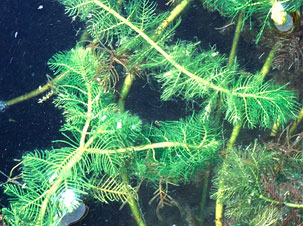
Phragmites australis is abundant throughout the Great Lakes region.
By Natasha Blakely
Invasive plants can grow so thick and tall that they can hide the world’s greatest lakes.
“In the lower part of the state it’s pretty bad,” said Laura Bourgeau-Chavez, a research scientist with Michigan Technological University. “We were doing work in Saginaw Bay, and there are kids who live there and they don’t even know there’s water there because the weeds are so tall.
“So they’re unable to take advantage of the fact that they live next to a Great Lake.”
Help is on the way.
Bourgeau-Chavez maps wetlands and monitors them in the field. Right now she is focusing on phragmites, a plant with a particularly strong presence in Saginaw Bay, Lake Erie and Lake St Clair.
But the plant has spread elsewhere. Sometimes it is more of a question of where aren’t there phragmites, she said.
Michigan Tech has multiple projects to curtail the spread of species like phragmites and Eurasian watermilfoil. They are funded by the Michigan Invasive Species Grant Program and the Great Lakes Restoration Initiative.
Bourgeau-Chavez heads the phragmites project. Her focus is on removing the nitrogen and debris that are the source of the problem. Attacking the phragmites alone will not take care of them, she said.
That’s not the only plant problem the university is addressing.
It is also working with the Les Cheneaux Watershed Council, testing if small doses of a native fungus — Mycoleptodiscus terrestris — will kill Eurasian watermilfoil.

Eurasian watermilfoil
Les Cheneaux is a group of islands stretching along 12 miles of Lake Huron’s north shoreline. The watershed council found that the fungus could kill small amounts of watermilfoil. Research scientist Colin Brooks is working to see if larger scale use of it will have the same impact.
It is a matter of common interest, said Robert Smith, president of the Les Cheneaux Watershed Council. The council is familiar with the area, the problem and the method, he said. The university has the technology.
Brooks has used drones for five years by helping the Department of Transportation inspect bridges. His background, however, is in ecology and he has wanted to combine the two.
“We’re able to lift up aerial cameras and also, as far as I know, unique to my project, we’re putting up multi-spectral cameras,” Brooks said. That allows them to collect multiple bands of light that help distinguish the watermilfoil from other submerged vegetation.
This means that Brooks can more effectively map where the invasion is happening and how successful different control methods curtail the plant.
If the drones identify which control methods work best and help us understand why, “we may be able to use less herbicide and more native organisms to control milfoil,” he said.
Since the lake level increased, the watermilfoil has not been as dense, Smith said. But three years ago it was so thick boats could not transit some of the Les Cheneaux bays.
“If it’s going to return in high density, it’s a matter of when it returns,” Smith said.
It is important not to wait for the worst of the watermilfoil to return, Smith said. It will be harder to combat and native species will be vulnerable to the more aggressive watermilfoil. The result could be a monoculture of Eurasian watermilfoil.
“When you lose diversity, you lose resiliency of the prior ecosystem to respond to stresses,” Smith said.
The projects are still in their beginning stages. Michigan Tech will continue to observe and combat these invasive plants over the next year before it reassesses the projects and their effectiveness, Bourgeau-Chavez said.
